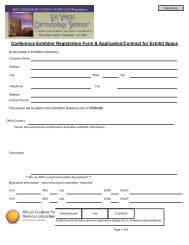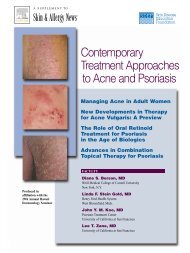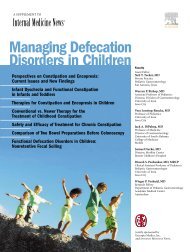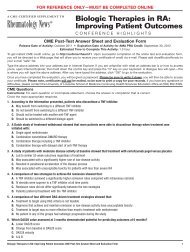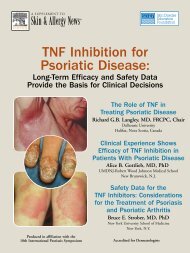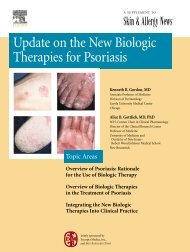Skin & Allergy News® - Global Academy for Medical Education
Skin & Allergy News® - Global Academy for Medical Education
Skin & Allergy News® - Global Academy for Medical Education
Create successful ePaper yourself
Turn your PDF publications into a flip-book with our unique Google optimized e-Paper software.
The vehicle base of the clindamycin/tretinoin<br />
combination is an aqueous<br />
polymer gel containing no alcohol. In the<br />
gel vehicle, crystalline tretinoin, dissolved<br />
tretinoin, and solubilized clindamycin are<br />
in equilibrium; as the product penetrates<br />
the skin, the equilibrium is upset, causing<br />
the crystalline component to dissolve.<br />
The “phased release” of tretinoin means<br />
that less unbound retinoid is present in<br />
the skin, reducing irritation. Tolerability<br />
may be further enhanced by the antiinflammatory<br />
effects of clindamycin.<br />
New Molecule<br />
The pooled data from two phase III<br />
clinical trials demonstrated the efficacy<br />
and safety of a new molecule called dapsone<br />
gel, 5%. 9 The combined total of<br />
3,010 study participants had mild to<br />
severe acne (most of the subjects—<br />
approximately 60%—had moderate<br />
acne).<br />
More than 40% of the patients<br />
treated in these trials achieved scores of<br />
FIGURE 1. 12-Week Results on GES of Adapalene/<br />
Benzoyl Peroxide (BPO) Fixed Combination<br />
Percentage of Patients Achieveing Success* Success Rate<br />
30%–<br />
25%–<br />
20%–<br />
15%–<br />
10%–<br />
5%–<br />
AdaBPO<br />
Adapalene<br />
BPO<br />
Vehicle<br />
clear or nearly clear. In the subset of<br />
patients with severe acne, approximately<br />
50% improved to at least mild acne. The<br />
difference between the active treatment<br />
group and the vehicle-only group was statistically<br />
significant.<br />
A total of five dermal safety studies<br />
showed no phototoxicity, irritation, photoallergic<br />
response, sensitization, or contact<br />
hypersensitivity. Reported local<br />
adverse effects <strong>for</strong> the active drug compared<br />
to vehicle alone were oiliness, peeling,<br />
dryness, erythema, burning, and<br />
rash. The most commonly reported systemic<br />
adverse effects <strong>for</strong> the active drug<br />
were nasopharyngitis (4.8%), upper respiratory<br />
infection (3.2%), headache<br />
(3.1%), pharyngitis (2.5%), cough,<br />
(2.1%), sinusitis (1.9%), and dysmenorrhea<br />
(0.5%).<br />
Conclusion<br />
The evidence reviewed here demonstrates<br />
the efficacy and safety of promising<br />
newly available and emerging topical<br />
0%–<br />
Week 1 Week 2 Week 4 Week 8 Week 12<br />
GES=<strong>Global</strong> Evaluation Scale<br />
Source: Thiboutot et al. 6 Reprinted with permisison. ©Elsevier Inc.<br />
FIGURE 2. 12-Week Results on GES of Clindamycin 1.2%/<br />
Tretinoin 0.025% Gel (CLIN/RA)<br />
25%<br />
20%<br />
15%<br />
10%<br />
5%<br />
21%<br />
16%<br />
0%<br />
CLIN/RA Gel Clindamycin Tretinoin Vehicle<br />
N=845 N=426 N=846 N=423<br />
GES=<strong>Global</strong> Evaluation Scale<br />
The vehicle <strong>for</strong>mulation used in all treatment arms was the same as the clindamycin/tretinoin vehicle gel.<br />
*Defined as clear or almost clear at Week 12.<br />
Source: Adapted from Ziana prescribing in<strong>for</strong>mation. Available at:<br />
http://www.medicis.com/products/pi_ziana.pdf. Accessed April 19, 2008.<br />
14%<br />
CLIN/RA Gel<br />
Clindamycin<br />
Tretinoin<br />
Vehicle<br />
8%<br />
therapies that clinicians should consider<br />
as new options in the treatment of<br />
patients with acne vulgaris. These therapies<br />
include two combination products:<br />
clindamycin 1.2%/tretinoin 0.025% gel<br />
and adapalene 0.3%/benzoyl peroxide<br />
0.25%. In addition, new <strong>for</strong>mulations of<br />
adapalene (0.3% strength) and clindamycin<br />
(in a foam vehicle) have been<br />
developed, as has a topical dapsone 5%<br />
gel.<br />
The evidence available to date on<br />
these fixed combination products further<br />
confirms and extends the concept that<br />
combination drugs affect multiple areas<br />
of pathophysiology. All of the products<br />
discussed in this article are among<br />
advances that offer clinicians more treatment<br />
options in providing care <strong>for</strong> their<br />
patients with acne vulgaris.<br />
References<br />
1. Pariser DM. The efficacy and safety of adapalene<br />
gel 0.3% in the treatment of acne vulgaris:<br />
A randomized, multicenter, investigator-blinded,<br />
controlled comparison study versus adapalene<br />
gel 0.1% and vehicle. Cutis. 2005;76:145-151.<br />
2. Thiboutot D, Pariser DM, Egan N, et al.<br />
Adapalene gel 0.3% <strong>for</strong> the treatment of acne<br />
vulgaris: A multicenter, randomized, doubleblind,<br />
controlled, phase III trial. J Am Acad<br />
Dermatol. 2006;54:242-250.<br />
3. Shalita AR, Myers JA, Krochmal L,<br />
Yaroshinsky A. The safety and efficacy of clindamycin<br />
phosphate foam 1% versus clindamycin<br />
phosphate topical gel 1% <strong>for</strong> the<br />
treatment of acne vulgaris. J Drugs Dermatol.<br />
2005;4:48-56.<br />
4. Leyden J. Comparing facial tolerability of a 3-<br />
step acne system containing a novel solubilized<br />
5% benzoyl peroxide lotion <strong>for</strong> normal to dry<br />
skin with that of a benzoyl peroxide/<br />
clindamycin combination prescription product.<br />
J Am Acad Dermatol. 2008;58(suppl 2):AB15.<br />
5. Strauss JS, Krowchuk DP, Leyden JJ, et al.<br />
Guidelines of care <strong>for</strong> acne vulgaris management.<br />
J Am Acad Dermatol. 2007;56:651-663.<br />
6. Thiboutot DM, Weiss J, Bucko A, et al.<br />
Adapalene-benzoyl peroxide, a fixed-dose combination<br />
<strong>for</strong> the treatment of acne vulgaris:<br />
Results of a multicenter, randomized doubleblind,<br />
controlled study. J Am Acad Dermatol.<br />
2007;57:791-799.<br />
7. Pariser DM, Westmoreland P, Morris A, Gold<br />
MH, Liu Y, Graeber M. Long-term safety and<br />
efficacy of a unique fixed-dose combination gel<br />
of adapalene 0.1% and benzoyl peroxide 2.5%<br />
<strong>for</strong> the treatment of acne vulgaris. J Drugs<br />
Dermatol. 2007;6:899-905.<br />
8. Schlessinger J, Menter A, Gold M, et al.<br />
Clinical safety and efficacy studies of a novel<br />
<strong>for</strong>mulation combining 1.2% clindamycin<br />
phosphate and 0.025% tretinoin <strong>for</strong> the treatment<br />
of acne vulgaris. J Drugs Dermatol.<br />
2007;6:607-615.<br />
9. Draelos ZD, Carter E, Maloney JM, et al <strong>for</strong><br />
the United States/Canada Dapsone Gel Study<br />
Group. Two randomized studies demonstrate<br />
the efficacy and safety of dapsone gel, 5% <strong>for</strong><br />
the treatment of acne vulgaris. J Am Acad<br />
Dermatol. 2007;56:439.e1-e10.<br />
10 Therapeutic Challenges and New Approaches to the Patient With Acne





